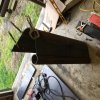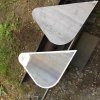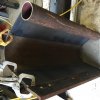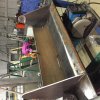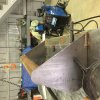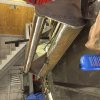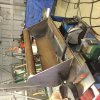Leading Edge Attachments, Inc. formerly carried a 2-Way Bucket. The patent is held by a childhood friend of mine, but it is not now in production. The following describes it pretty well. Since you'd not be building it for sale, there probably wouldn't be any restrictions on anyone's building one.
Allows the operator to have a shovel style bucket and a trenching style bucket at the same time. The internal swinging plate has welded stops that allow the plate to swing back and forth and hold the material on which ever side the operator chooses to use. When the trenching side is used, the baffle swings toward the rear and the stops hold the baffle plate to hold the material. When the shovel side is used, the baffle plate swings toward the front and the stops hold the material in that position. The capacities of either side are approximately the same. The uses for this combination trenching and shovel bucket are endless. Operators have claimed that they gain more than 50% increase in productivity with the use of this bucket.
The following lists some of this bucket's advantages:
Universal Advantages
Matches or outperforms conventional buckets in traditional hoe-to-hoe or shovel-to-shovel assignments.
Reduces crew time in almost every two-way scenario.
Reduces crew exposure in almost every two-way scenario.
Cost (time) saving potential in every working environment.
Constructed of abrasion-resistant steel.
Bedding Materials Installation
Excavates spoil and lays bedding material in a single pass.
Minimizes or eliminates trench-wall weeping.
Minimizes or eliminates cave-ins.
Minimizes or eliminates contamination of bedding materials by trench-wall encroachment.
Minimizes or eliminates bedding materials waste
Minimizes or eliminates requirement for second machines (wet conditions, etc.)
Dump Truck Unloading (shovel position)
Minimizes or eliminates dump-body latch damage.
Minimizes or eliminates dump truck down time from body damage.
Minimizes or eliminates the need to safety chain tailgates.
Increases dump truck effectiveness by unloading a significantly greater amount of the dump-truck load.
Trench (Shield) Box Placement and Removal
Reduces or eliminates need for slings & chains
Reduces or eliminates undue force on box during installation
Reduces or eliminates undue force on box during extraction
Reduces or eliminates machine relocation
Doubles lifting opportunities
Mass Excavation/Rubble Loading
From a single machine position, capture and load from both sides of the pile
Reduces and usually eliminates pile chasing
Reduces and usually eliminates requirement for a second machine
Precision Digging
Digs all corners square.
Reduces or eliminates over-excavation.
Digs to dimensions, not beyond.
Greatly reduces the need for backfill or flowable fill.
Irregular spoil often removed within the desired excavation.
Reduces or eliminates machine relocations.
Digs closer around utilities, reducing or eliminating the need for hand shoveling and premature backfill.
Using shovel action, excavates closely beside existing pipes with little threat of rupture or need for hand shoveling.
When the desired excavation is within reach of one machine location, can dig all corners from one location.
Bucket Reconfiguration/Reversing
(Shovel to Hoe -- Hoe to Shovel)
Conventional bucket -- 5 to 90 minutes lost
Unrecoverable loss of machine time
Unrecoverable loss of crew time
Mechanic often required
2-Way Excavator Bucket™
Merely work in the opposite direction –It’s as easy as having the thought and just as fast!!
No machine time loss
No crew time loss
Mechanic not required

